Astrophotos of a few very special scenes I like very much. I don’t like to put them to one of my other topics, hence I put them here. I like scenes which show objects with differente characters at on picture. The more diverse the objects the more interesting this encounters scene is for me. Sometimes inner galactic and sometimes extra galactic ones.
For comets and apparent close encounters of comets and deep sky objects there is a separate page.
SN2023ixf in M 101
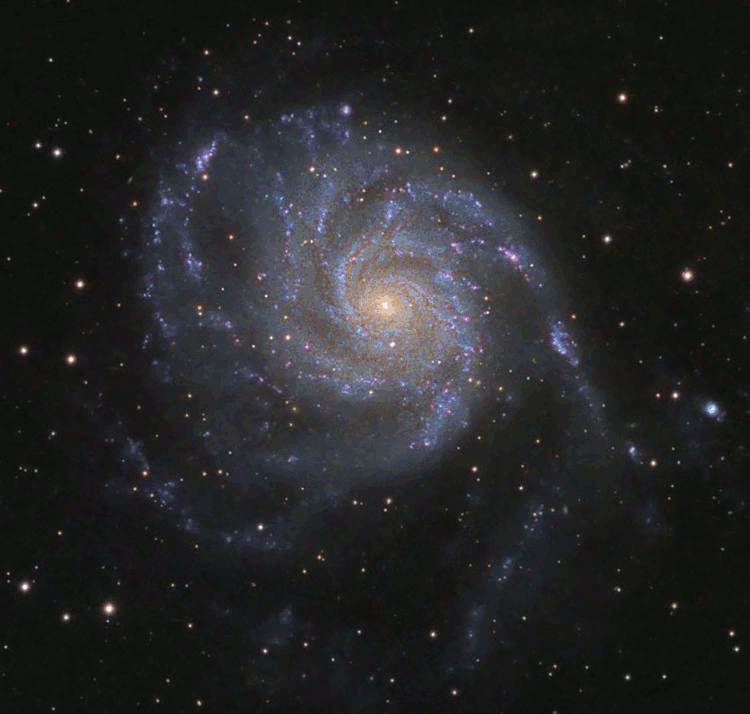 Actually not an encounter but anyway something unusual. Hence I put it to this collection. The scale is 1.01 arc sec / pix and north is up roughly. M 101 is a famous SAB spiral in Ursa Major seen from the top, sometimes called Pinwheel. Though it is a „Messier Object“ it has a quite low surface brightness of about 14,6 mag / arc sec2. Hence it requires a dark sky, not really the case at my home. The small animated gif above blinks the picture with another one taken with my Esprit in March 2020. Despite the supernove it reveals some progress of my picture processing. The picture below is actually to deep for a supernova shot. For this goal a few minutes would have been long enough, but I couldn’t stand the challange to shot a pretty picture as well.
Actually not an encounter but anyway something unusual. Hence I put it to this collection. The scale is 1.01 arc sec / pix and north is up roughly. M 101 is a famous SAB spiral in Ursa Major seen from the top, sometimes called Pinwheel. Though it is a „Messier Object“ it has a quite low surface brightness of about 14,6 mag / arc sec2. Hence it requires a dark sky, not really the case at my home. The small animated gif above blinks the picture with another one taken with my Esprit in March 2020. Despite the supernove it reveals some progress of my picture processing. The picture below is actually to deep for a supernova shot. For this goal a few minutes would have been long enough, but I couldn’t stand the challange to shot a pretty picture as well.
 Object: SN2023ixf in M 101; 2023, May 25th, Borgfeld
Object: SN2023ixf in M 101; 2023, May 25th, Borgfeld
Scope: 10″ Newton at f/2.8
Camera: Atik 490EXm, RGB 10/10/10 x 2 min each at 2×2 binning, L 30 x 4 min, no binning, 3 h at all
Mount: Avalon Linear
Guiding: off-axis, Lodestar, PHD2
Processing: SQM Pro, PI
SN2022ewj
![]() The scale is 1.01 arc sec / pix and north is up. NGC 3367 is the spiral seen from the top. It comes along with NGC 3373 NE of center, NGC3391 at the upper left corner and many small galaxies listed in the PGC catalog.
The scale is 1.01 arc sec / pix and north is up. NGC 3367 is the spiral seen from the top. It comes along with NGC 3373 NE of center, NGC3391 at the upper left corner and many small galaxies listed in the PGC catalog.
Object: SN2022ewj in NGC 3367; 2022, March 25th, Borgfeld
Scope: 10″ Newton at f/2.8
Camera: Atik 490EXm, RGB 25/25/25 x 2 min each, L 25 x 2 min, 5 h at all
Mount: Avalon Linear
Guiding: off-axis, Lodestar, PHD2
Processing: SQM Pro, PI
NGC 7497 and Integrated Flux Nebula
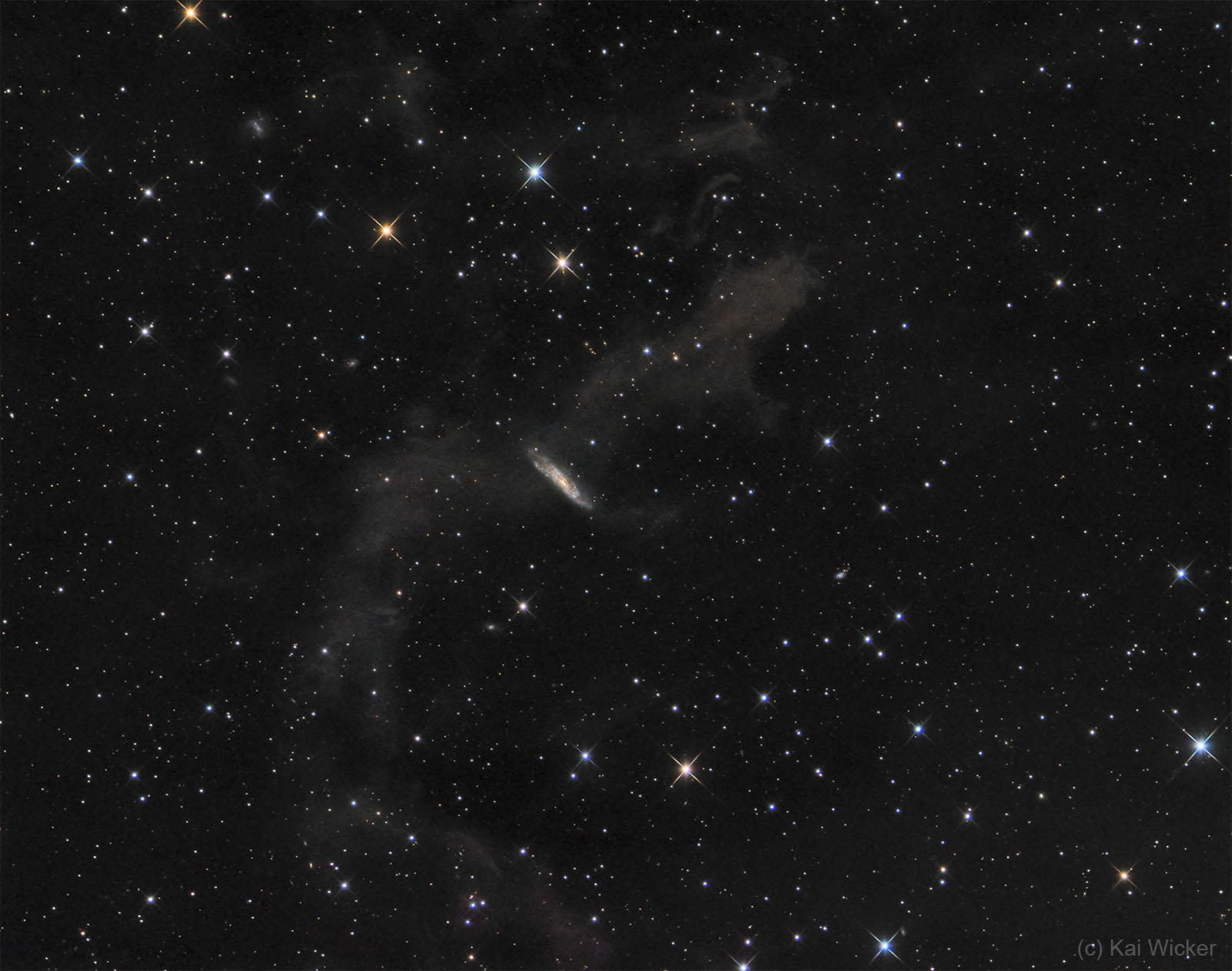 Shot at Sept 2nd, 2020 in Borgfeld. It is always a difficult job to catch these quite dark nebulas. During nights with good transparency the light polution at my site – a suburban area of Bremen – bugs a bit less and I can try to do shots as this. I’m often disillusioned comparing the results to photos taken from dark places. These darker clouds challenge me, anyway.
Shot at Sept 2nd, 2020 in Borgfeld. It is always a difficult job to catch these quite dark nebulas. During nights with good transparency the light polution at my site – a suburban area of Bremen – bugs a bit less and I can try to do shots as this. I’m often disillusioned comparing the results to photos taken from dark places. These darker clouds challenge me, anyway.
Atik 490EXm with Baader LRGB: 72/25/25/25 x 2 min or 5 h at all with my 10″ Newton at f/2.8 on my Avalon Linear and off-axis guiding. The picture was processed with Pixinsight and finally some minor adaptations with Photoshop. North is up and the scale is 1.01 arc sec / pix.
NGC 7497 is a SAc spiral inside the Perseus square close to Markab with approx. 13.3m and an apparent size of 3 x 1 arcmin [The Sky live]. Simbad reports a distance of the order of 16 Mpc. The interesting thing is the molecular cloud. It is catalogized as MBM 54 at galactical coordinates 091.6314° / -38.1028°. 2014ApJ…786…29S reports a distance of approx. 231 pc of this cloud which is part of a larger complex itself. This larger complex is elongated almost perpendicular to the galactic plane and spans more than 9° the sky [1985ApJ…295..402M].
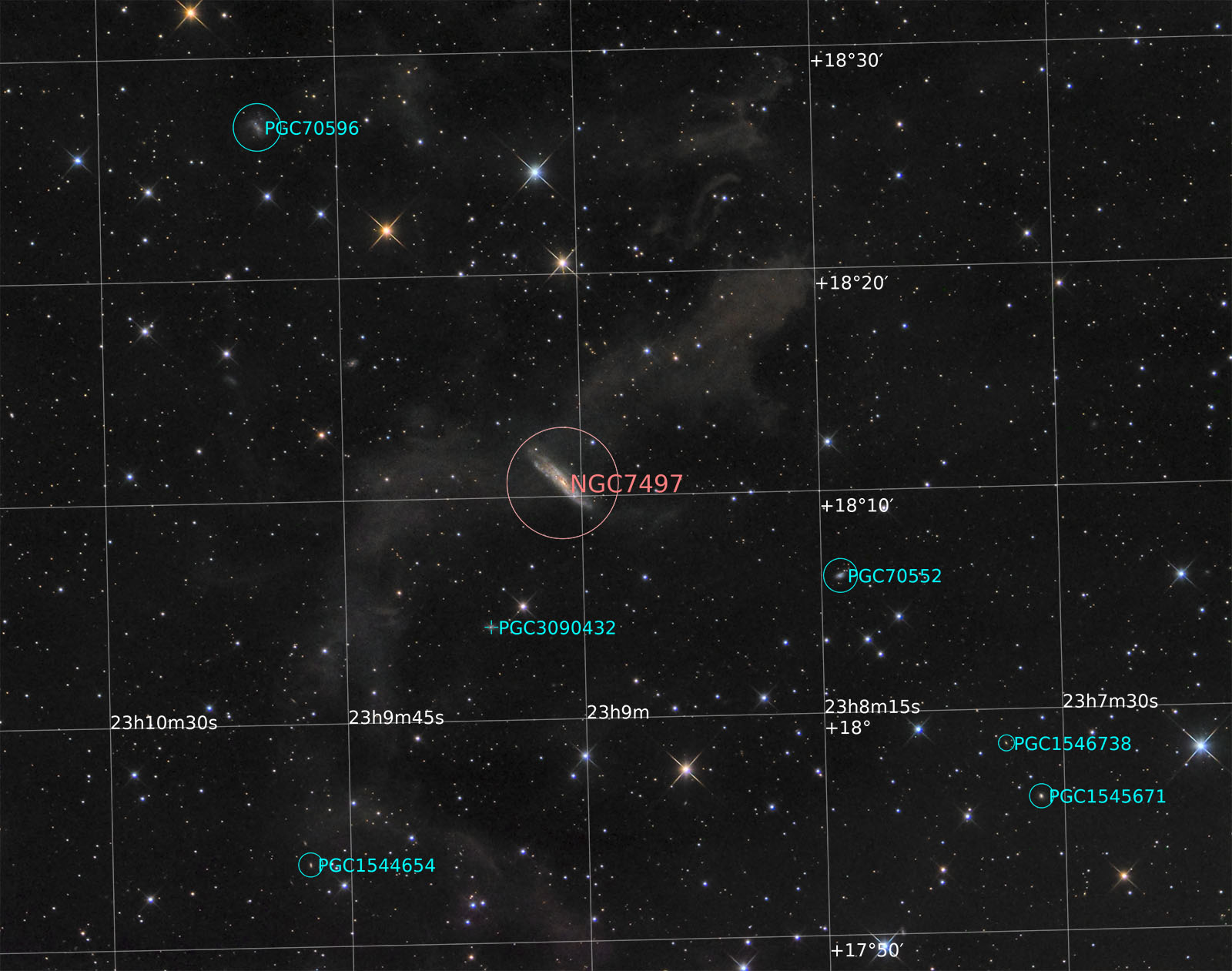 Compared to the dirty cloud in our neighbourhood NGC 7497 ist almost 70000 times further away. From that point of view this is not really a close encounter, but apparently.
Compared to the dirty cloud in our neighbourhood NGC 7497 ist almost 70000 times further away. From that point of view this is not really a close encounter, but apparently.
Nearby NGC 7497 many smaller galaxies are visible at this photo. The annotated picture indicates these objects.
NGC 6946 and NGC 6939
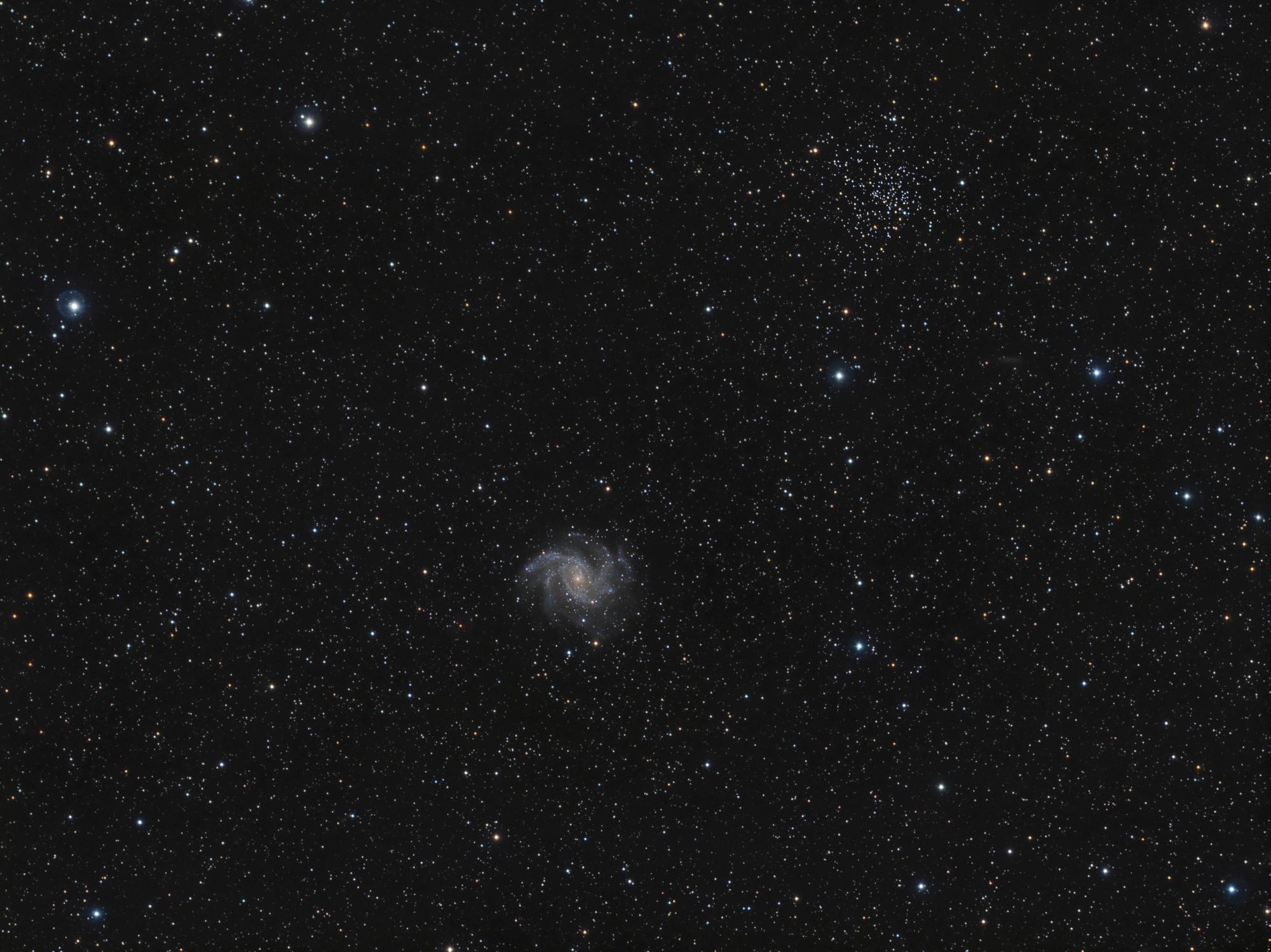 NGC 6946 und NGC 6939 in der Nacht vom 11. auf den 12.10.2015 im Borgfelder Garten. Es war die zweite Nacht mit meiner neuen laufenden Linear. Ich wollte mal sehen, ob das System auch bei 600mm Brennweite gut läuft. Es lief gut. Es wurde die gesamte Nacht (Abenddämmerung bis Morgendämmerung, bzw. bis das Objekt durch Bäume verdeckt wurde) belichtet. An effektiv verwendbaren Frames habe ich erzeugt: 13x8min L = 104min, 10x8min R = 80min, 11x8min G = 88min, 11x8min B = 88min, Summe = 6h.
NGC 6946 und NGC 6939 in der Nacht vom 11. auf den 12.10.2015 im Borgfelder Garten. Es war die zweite Nacht mit meiner neuen laufenden Linear. Ich wollte mal sehen, ob das System auch bei 600mm Brennweite gut läuft. Es lief gut. Es wurde die gesamte Nacht (Abenddämmerung bis Morgendämmerung, bzw. bis das Objekt durch Bäume verdeckt wurde) belichtet. An effektiv verwendbaren Frames habe ich erzeugt: 13x8min L = 104min, 10x8min R = 80min, 11x8min G = 88min, 11x8min B = 88min, Summe = 6h.
TLAPO906 mit 2″-Reducer dann mit 480mm Brennweite auf Avalon Linar und Baader Hartholzstativ. Die Guidingkonfiguration hatte ich seit den letzten Versuchen mit meiner neuen Avalon Linear massiv geändert: Lodestar am 60/240mm Sucher, PHD2 2.5.0 pre5, ASCOM Lodestar-Treiber nicht der PHD2-Treiber. DarkPixelMap, 3×3 median-Rauschfilterung, keine Subframes. Beide Achsen mit Hysteresis Algorithmus mit Agressivität:90, Hysterese: 5, min-motion: 0.03.
NGC 6939 ist ein offener Sternhaufen vom Typ I1m im Cepheus NGC 6939 hat eine Winkelausdehnung von 8′ x 8′ und eine scheinbare Helligkeit von +7,80 mag. Seine Entfernung wird zwischen 4000 und 9000 Lichtjahren geschätzt, da der Bereich zwischen ihm und dem Sonnensystem durch interstellarer Materie stark „verschmutzt“ ist. Mit einem Alter von rund 1,6 Milliarden Jahren ist NGC 6939 eines der ältesten bekannten Objekte dieser Art. Entdeckt wurde das Objekt am 9. September 1798 von William Herschel, zusammen mit der nur vierzig Bogenminuten südöstlich gelegenen Spiralgalaxie NGC 6946. NGC 6946 oder auch Feuerwerksgalaxie ist die Bezeichnung einer Spiralgalaxie im Sternbild Cepheus an der Grenze zum Sternbild Cygnus. NGC 6946 hat eine Winkelausdehnung von 11,5′ × 9,8′ und eine scheinbare Helligkeit von 9,0 mag. Die Galaxie liegt nahe unserer galaktischen Ebene, daher wird das Licht, das von NGC 6946 zu uns kommt, durch Gas und Staub aus unserer Galaxie stark abgedunkelt. Dies erschwert die Beobachtung dieser Galaxie und ihrer Mitglieder und besonders auch die Bestimmung ihrer Entfernung. Eine im Jahre 1997 veröffentlichte Berechnung ergab eine fotometrische Distanz von 5,4 Mpc (21 Mio. Lj). Andere Messungen ergaben Werte zwischen 4,1 und 10,5 Mpc. NGC 6946 führt die Statistik der Supernova-Häufigkeiten in den letzten 100 Jahren mit einer Anzahl von neun an.
NGC 6946 wurde am 9. September 1798 vom deutsch-britischen Astronomen Friedrich Wilhelm Herschel entdeckt (www.wikipedia.de).
PreProcessing und Stacking mit PI. Linearer Bereich mit PI: Gradienentfernung, separat für alle Farbkanäle RGB zusammengesetzt, Farbkalibaration sehr schwierig, Hintergrund über MergePreview, LRGB zusammengesetzt, Hintergrund sehr leicht mit Luninanzmaske, MLT k-Sigma Noise Thresholding entrauscht, nochmalige Gradientenentfernung mit ABE, PSF ermittelt, Decon, mit Luminanzmaske auf helle Anteile, local support, 60 Iterationen, inverse Sternenmaske und Luminanzmaske erstellt, daraus per Min die Objektmask, OM bearbeitet mit CloneStamp und HistogrammTransformation.
Stecken mit PI: manuell mit HistogrammTransformation, Schwarzpunkt angepasst, weiter mit OM, Sättigung mit Curves, erst gesamtes Bild dann nur Nebel mit OM.
Nichtlinearer Bereich mit PS: Auswahl mit Zaubestab: GC leicht geschärft um ihn aus dem Bild hervorzuheben. Auswahl der Gx mit Zauberstab, leicht geschärft, dabei Sterne ausgenommen, BigStars reduziert mit abgedunkelter, hinterlegter Ebene, gesamtes Bild ganz leicht entrauscht.
Sculptor galaxy with globular cluster
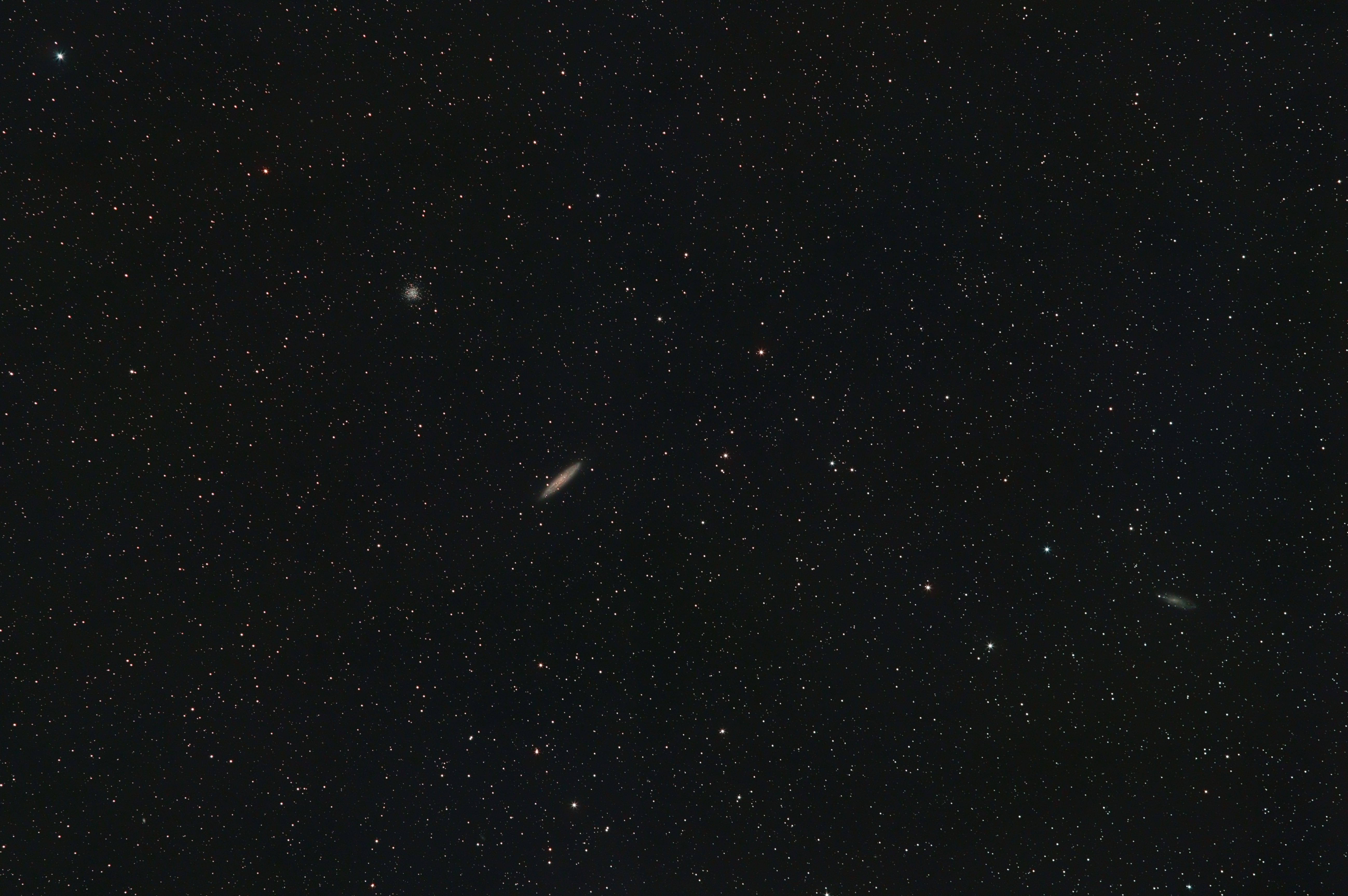 The special thing of that picture is in the dimensions.The Sculptor galaxy is one of the brightest galaxy out of our local group at a distance of about 10 mly. The globular cluster NGC 288 is as a companion of our milky way only 30000 ly away. More.
The special thing of that picture is in the dimensions.The Sculptor galaxy is one of the brightest galaxy out of our local group at a distance of about 10 mly. The globular cluster NGC 288 is as a companion of our milky way only 30000 ly away. More.
M 52 und NGC 7645
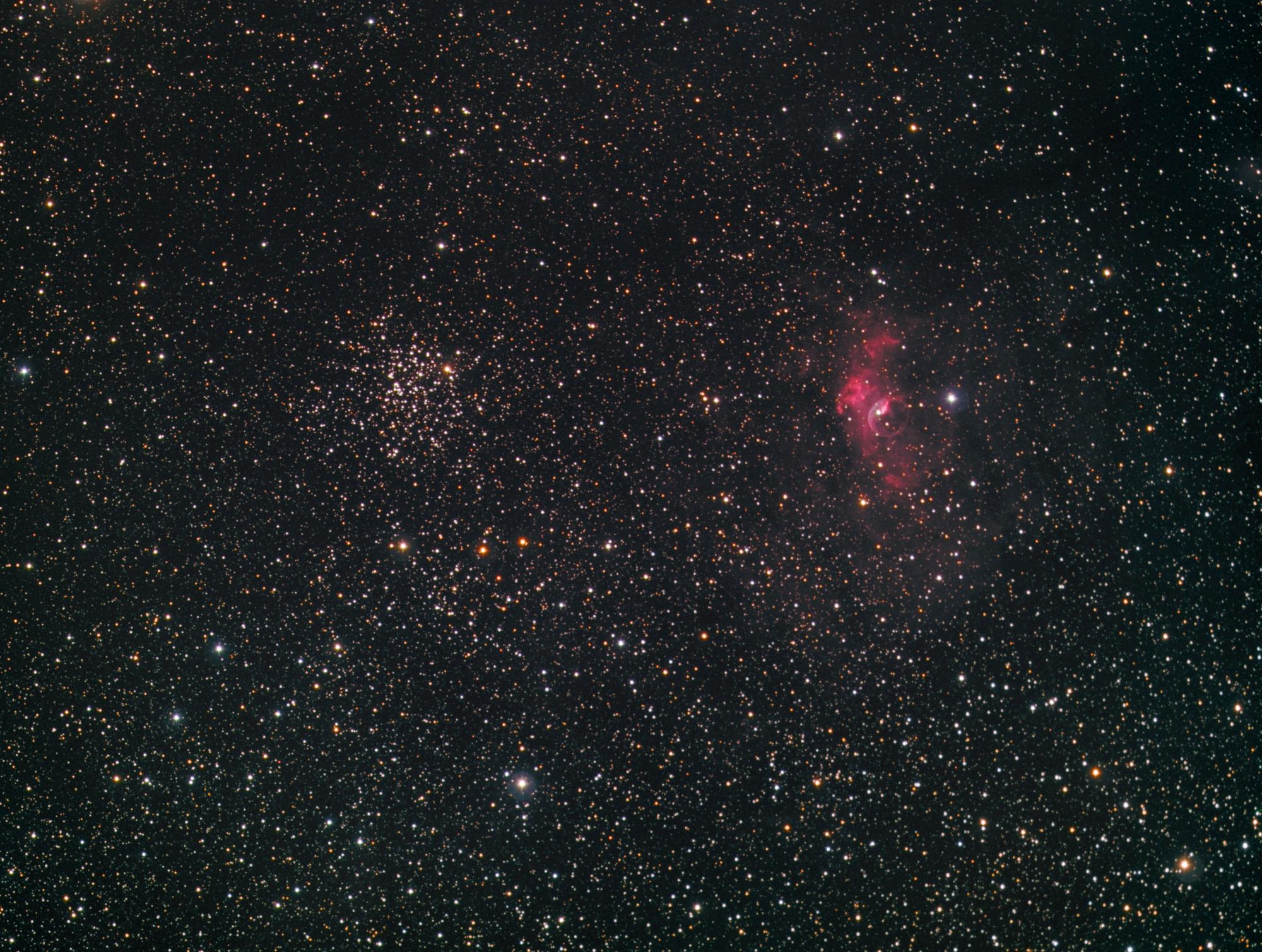 Aufgenommen am 24 November 2013. TLAPO906, 2″ Flattener 119mm Abstand, Atik 383L+ mit FW2 und Baader LRGB Filtersatz, fokussiert mit Bathinovmaske und dann per SQMpro Autofokus ca. alle 23min. Aufnahmesteuerung per SQMpro. Baader LRGB-Filtersatz. Sucherguiding per PHD Guiding mit Lodestar 135er Tele mit 3x Barlow. GP-2 auf Baader Hartholzststiv.
Aufgenommen am 24 November 2013. TLAPO906, 2″ Flattener 119mm Abstand, Atik 383L+ mit FW2 und Baader LRGB Filtersatz, fokussiert mit Bathinovmaske und dann per SQMpro Autofokus ca. alle 23min. Aufnahmesteuerung per SQMpro. Baader LRGB-Filtersatz. Sucherguiding per PHD Guiding mit Lodestar 135er Tele mit 3x Barlow. GP-2 auf Baader Hartholzststiv.
Belichtung: L 12x8min = 96min, 1x1er binning; R 5x4min = 20min 2x2er binning; G 6x4min = 24min 2x2er binning; B 6x4min = 24min 2x2er binning;
Summe: 174min LRGB = 2h44min. Je 25 Darks, Offsets und pro Farbkanal 25 Flats. MaximDL: Stacking, manuell geebnet, crop. Speicherung aller Daten als float32 FIT. Fitswork: Farbabgleich per Auge. nach TIFF gewandelt. RGB-Bearbeitung / StarTools: Contrast, Denoise. L-Bearbeitung / Startools: DDP, Schärfen, Rauschfilterung. Photoshop: NGC7635-RGB aus man flat crop ST.tiff und NGC7635-Lumi man flat crop ST.tiff zusammengesetzt und als JPG gespeichert.
M 97 und M 108
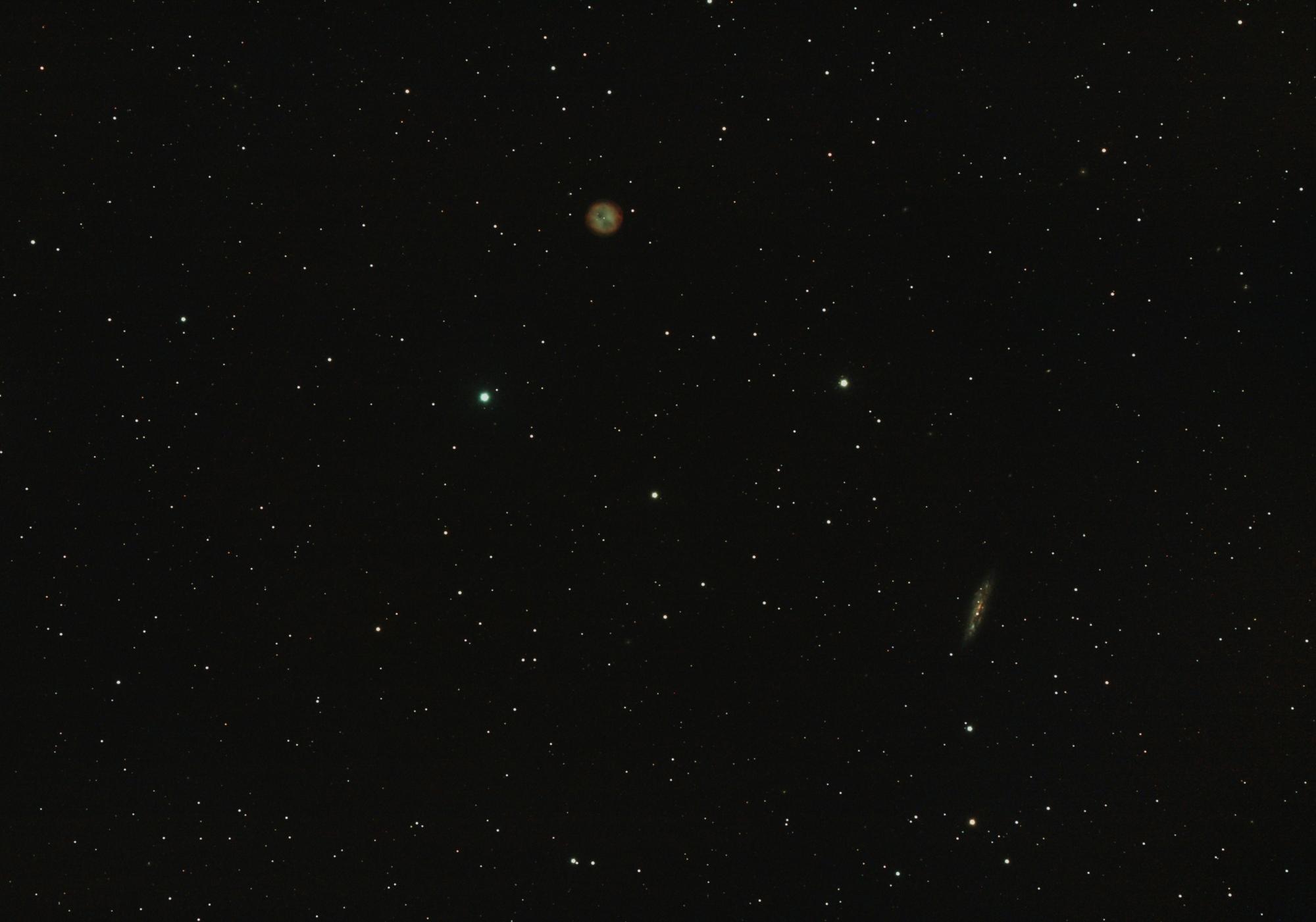 Aufgenommen in der Nacht vom 16.04.12 den 17. Erstes Set-Up mit Lodestar am 135mm Teleobjektiv als Guider. Da die Lodestar-SW nicht funktionierte, habe ich PHD-Guiding eingesetzt. Heute weiss ich, dass es ein Bedienungsfehler war. Ich werde es demnächst erneut ausprobieren müssen. Eigentlich war ja nur eine Inbetriebnahme geplant. Deshalb hatte ich das Scope nicht mal pojustiert. Als dann gegen 23:00 Uhr eigentlich alles gut lief und die Wolken doch noch abzogen, habe ich eben die Kamera angebaut. Mit M 97 hatte ich ja sowieso noch eine Rechnung offen. Das nächste Mal wieder mit angeschlossenem CdC. Ist einfach komfortabler so. Muss ja nicht mehr über EQASCOM sein.
Aufgenommen in der Nacht vom 16.04.12 den 17. Erstes Set-Up mit Lodestar am 135mm Teleobjektiv als Guider. Da die Lodestar-SW nicht funktionierte, habe ich PHD-Guiding eingesetzt. Heute weiss ich, dass es ein Bedienungsfehler war. Ich werde es demnächst erneut ausprobieren müssen. Eigentlich war ja nur eine Inbetriebnahme geplant. Deshalb hatte ich das Scope nicht mal pojustiert. Als dann gegen 23:00 Uhr eigentlich alles gut lief und die Wolken doch noch abzogen, habe ich eben die Kamera angebaut. Mit M 97 hatte ich ja sowieso noch eine Rechnung offen. Das nächste Mal wieder mit angeschlossenem CdC. Ist einfach komfortabler so. Muss ja nicht mehr über EQASCOM sein.
TLAPO906 mit Flattener und 350Da, CLS-Clipfilter, GP-2 mit Guiding wie oben beschrieben. Diese Aufnahme 37x4min light, 39 darks, 11 flats und 21 offsets. Die 7 schlechtesten Frames habe ich weggelassen. Aufgenommen mint 400 ASA. Wäre besser mit 800 ASA gewesen, so war der Himmelshintergrund nicht annähernd geschwärzt.
Gestackt und nachbearbeitet mit IRIS und Photo Plus, dynamic stretching und color stretching, bias entfernt, leichtes Crop, Helligkeit und Kontrast angepasst.